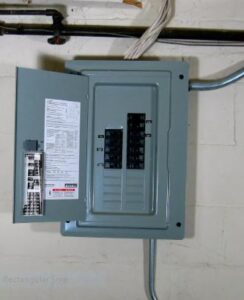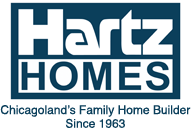 Many home DIY projects require turning off the power to the area where you’ll be working. Hartz Homes knows that this can be a little scary for the first-time homeowner. So, if this sounds like you, read on for a basic introduction to your home’s main electrical service panel.
Many home DIY projects require turning off the power to the area where you’ll be working. Hartz Homes knows that this can be a little scary for the first-time homeowner. So, if this sounds like you, read on for a basic introduction to your home’s main electrical service panel.
You may know the service panel as the breaker box, while in the trade it’s officially called a load center. The main service panel is like the switchboard for all the electricity in the home. It receives the incoming power from the utility company and distributes it to each of the circuits that supply the various lights, outlets, appliances, and other devices throughout the house. Everything but the incoming utility power can be shut off and turned on at the main service panel.
Behind the Panel Door
A service panel is a steel box with a hinged door or lift-up panel on the front. With the door open, you can access all the circuit breakers in the panel. Typically, one panel feeds the entire house, but there can also be another, smaller panel, called a subpanel, which may be used to serve a specific area, such as an addition, a large kitchen, or a detached garage. A subpanel works just like a main service panel but is supplied by the home’s main panel rather than directly by the utility lines.
Each circuit breaker is controlled with a lever that can be set manually to an ON or OFF position. If a circuit breaker trips, usually due to an overload or other problem with the circuit, the lever will automatically move to a third position between ON and OFF. Breakers should be labeled to identify the main area or appliance served by the breaker’s circuit. Labels may be stickers or hand-written words next to breakers or on a sheet adhered to the inside of the panel door. To shut one off, flip the lever to the “off” position. Test the device to make sure power is off before working on it.
Note: Older homes that have not had their electrical services upgraded may have service panels with fuses rather than circuit breakers, which have been standard since the 1960s.
Main Circuit Breaker
The main circuit breaker is a large breaker usually located at the top of the panel but sometimes near the bottom or along one side. It controls all the power of the branch circuit breakers (the breakers controlling individual circuits) in the panel.
Power comes from the utility service lines, flows through the electrical meter on the outside of your house, and continues into the service panel. However, some systems include a separate disconnect switch between the meter and the panel. The main breaker is used to turn power to all the branch circuits ON or OFF at the same time.
The main circuit breaker also identifies the total amperage capacity of the service panel and will have a number on it identifying its amp capacity, such as 100, 150, or 200. The standard for new panels today is 200 amps, but panels can have an even higher capacity.
Warning: The main circuit breaker shuts off the power to all of the branch circuits but does not shut off the power from the utility. The utility service lines and the terminals they connect to inside the panel remain live (carrying deadly electrical current) unless the utility company shuts off the service to the home.
Circuit Breakers
The circuit breaker is the weak link in each electrical circuit. But that’s a good thing, as it’s designed to fail safely. When a circuit draws more current than it is designed to handle, the wiring gets hot and becomes a fire hazard. Excessive current in a circuit is prevented by the use of overcurrent safety devices, such as circuit breakers. Circuit breakers come in a variety of types and capacities:
Single-pole breakers provide 120 volts and typically come with ratings of 15 amps or 20 amps. These breakers serve most of the circuits in your home.
Double-pole breakers provide 240 volts and come in ratings from 15 amps to 50 amps. These breakers usually serve dedicated circuits for large appliances, such as electric dryers, stoves, and air conditioners.
Ground-fault circuit-interrupter (GFCI) breakers protect an entire circuit from ground faults to help prevent shock hazards.
Arc-fault circuit-interrupter (AFCI) breakers protect an entire circuit from arc faults to help prevent house fires. Some dual-function breakers may provide both GFCI and AFCI protection simultaneously.
Please check out these new home communities from Hartz Homes:
Armitage Pointe of Addison, Illinois (Chicago area new home construction)
Bella Vista Townhomes of Bolingbrook, Illinois (Chicago area new home construction)
Blue Bell Ridge of Bolingbrook, Illinois (Chicago area new construction)
Lago Vista of Lockport, Illinois (Chicago area new home construction)
Leigh Creek of New Lenox, Illinois (Chicago area new home construction)
Marquis Pointe of Montgomery, Illinois (Chicago area new home construction)
Nantucket Lakes of New Lenox, Illinois (Chicago area new home construction)
Park West of Manteno, Illinois (Chicago area new home construction)
Playa Vista of Plainfield, Illinois (Chicago area new home construction)
Shannon Estates of New Lenox, Illinois (Chicago area new home construction)
Sky Harbor of New Lenox, Illinois (Chicago area new home construction)
Whisper Creek of Mokena, Illinois (Chicago area new home construction)
Hartz Homes has new home communities in:
Addison, Illinois (Chicago area new home construction)
Bolingbrook, Illinois (Chicago area new home construction)
Lockport, Illinois (Chicago area new home construction)
New Lenox (Chicago area new home construction)
Manteno, Illinois (Chicago area new home construction)
Mokena, Illinois (Chicago area new home construction)
Plainfield, Illinois (Chicago area new home construction)
